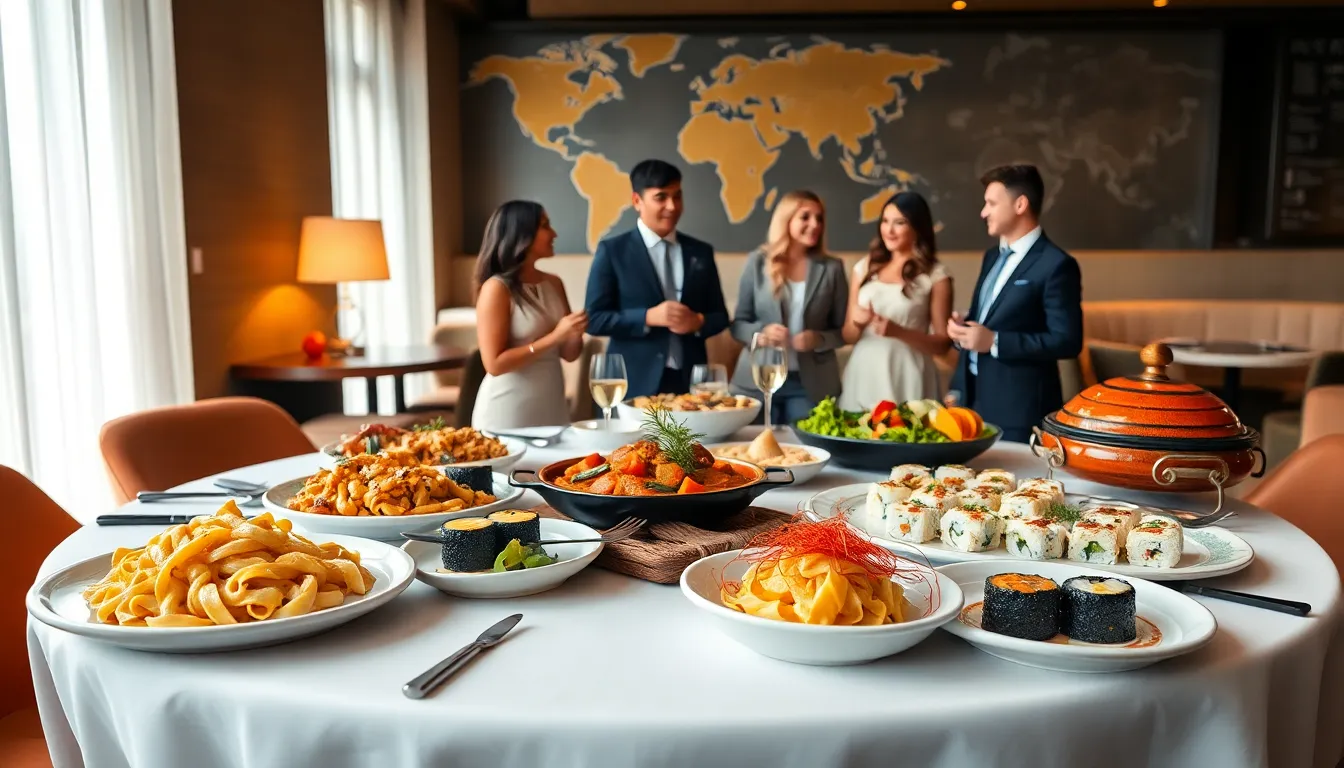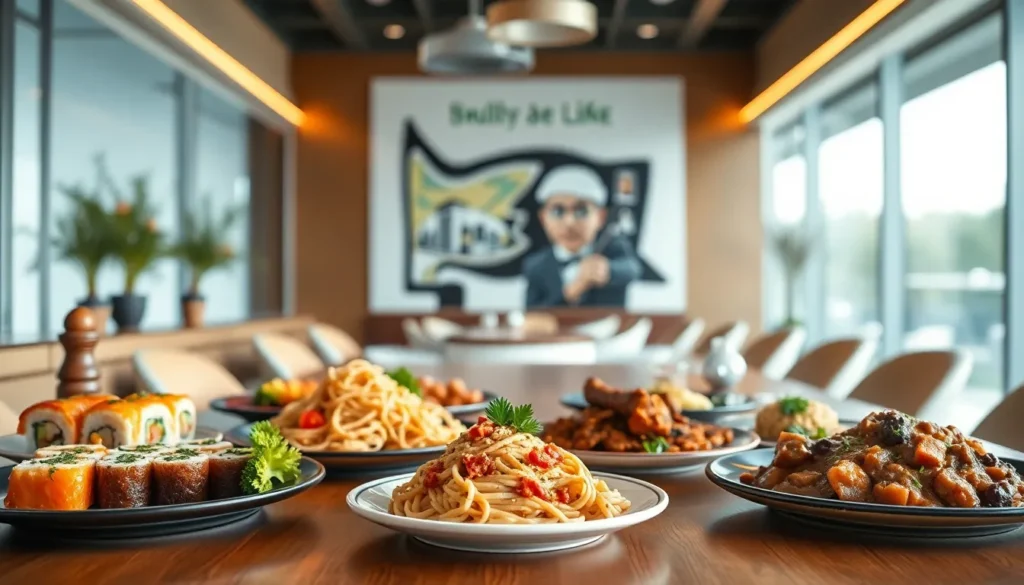Table of Contents
ToggleEver thought about how food could be the secret passport to exploring the world? Imagine traveling the globe, tasting dishes that tell stories, reveal traditions, and let you enjoy undeniably delicious moments. From savoring street food in Bangkok to enjoying Michelin-starred meals in Paris, the culinary journey is just as thrilling as the destination itself. Buckle up as we jump into various culinary delights, because, let’s face it, nobody ever came home from vacation raving about the airport food.
Exploring Global Culinary Traditions

Culinary traditions across the globe are anything but uniform. Each country brings its own flavors, cooking methods, and unique ingredients to the table. In Italy, for instance, pasta isn’t just food: it’s an art form passed down through generations. Each region flaunts its varieties, from the creamy rigatoni alla vodka of Rome to the delicate handmade tortellini of Bologna. Meanwhile, the spicy aromas wafting from a bustling street stall in India tell a tale of deeply rooted spices such as cardamom and cumin, skillfully balanced to create mouthwatering dishes like biryani or masala dosa.
In Japan, sushi goes beyond mere food: it’s a refined culinary experience, an intimate ritual that reflects harmony, cleanliness, and freshness, elements that hold deep significance in Japanese culture. Here, meals are carefully curated, often accompanied by an aesthetic presentation that transforms food into art. And who could overlook the enchanting flavors of Morocco? Tagines cooked slowly with an array of spices like saffron and paprika engage the senses, leading everyone on a flavorful journey combining sweet and savory like no other cuisine can.
Each culinary tradition serves as a window into the culture it emerges from, ensuring that every meal tells a narrative worth exploring.
Regional Specialties You Can’t Miss
When traveling, it’s essential to indulge in regional specialties that stand as culinaries’ pride. In the southern United States, dishes like gumbo or jambalaya tantalize the taste buds with their rich layers of flavors, embodying the heritage of Creole and Cajun influences. Moving northwards, Chicago deep-dish pizza serves up a hearty, cheesy canvas layered with tomato sauce and toppings that could make any food lover swoon.
In Latin America, nothing captures the essence of comfort food quite like Argentina’s empanadas. These delicious stuffed pastries come with fillings ranging from juicy beef to tangy cheese and pepper, providing a flavor explosion in every bite.
But let’s not forget France, the epicenter of culinary luxury. Often, delicacies such as escargots or duck confit entice the adventurous eager to broaden their palate. It’s here where skill meets tradition, resulting in dishes that truly reflect the French passion for gastronomy. Each of these specialties deserves a spot on anyone’s travel itinerary, adding richness to their culinary exploration.
Unique Food Experiences Around the World
Intrepid travelers know that beyond traditional meals are unique food experiences that transform ordinary trips into unforgettable memories. Consider dining under the stars in the Moroccan desert, where visitors enjoy a multisensory feast prepared by local chefs amidst the dunes, captivating both the palate and the spirit.
Alternatively, an interactive cooking class in Tuscany dives deep into the heart of Italian cooking. It’s not just about taste: it’s about learning how to make pasta from scratch while sipping on local wine, truly an immersive experience.
For those with a penchant for adventure, how about tasting a traditional Icelandic dish like hákarl? Fermented shark served with a shot of schnapps might sound daring, but it’s a rite of passage for food enthusiasts visiting this fascinating island. Such experiences often connect travelers more deeply with their destination, revealing layers of tradition that simple meals cannot convey.
Tips for Savoring Culinary Delights While Traveling
To make the most out of culinary adventures, it’s crucial to adopt a few practical tips. First off, steer clear of tourist traps, those bustling restaurants near the Eiffel Tower, for instance. Instead, seek out local gems where the real flavors lie. Asking locals for their favorite spots not only enhances food experiences but can also lead to discovering hidden culinary treasures.
Dare to taste street food. It’s often the most authentic representation of a culture’s gastronomy and can cost considerably less than sitting down at a restaurant. Just plan on enjoying those crispy fried tacos or steaming bowls of pho, and keep a lookout for places bustling with locals.
Documentation is key. Carry a small notebook or use an app to jot down flavors that stand out or interesting conversations with chefs, these details create lasting memories to reminisce about later. Above all, take your time to truly savor each bite, allowing flavors to mingle on your palate. This simple act transforms mere eating into a sensory celebration.
How to Create Your Own Culinary Travel Guide
Crafting a personal culinary travel guide might just be the adventure of a lifetime. Begin by researching regional cuisines, ingredients, and must-try dishes. Use resources like food blogs, travel documentaries, and social media platforms to gather insights. Create an itinerary that includes cooking classes or markets where local flavors come alive.
When you travel, take copious notes. Document every meal, from street vendors to renowned chefs, capturing restaurant names, special dishes, and even chefs’ names. These details will allow you to reminisce about your adventures long after you return home. Capture photos too, because a picture is worth a thousand words, especially in food photography.
Finally, share your culinary adventures with others. Blog, post on social media, or develop a small travel guidebook to inspire fellow foodies on their journeys. This process not only enriches your own travels but builds a community of culinary enthusiasts around you.
The Role of Food in Cultural Connections
Food transcends borders and serves as a powerful tool for cultural connections. When sharing a meal, barriers fall away, and people come together. In many cultures, food symbolizes hospitality. In some countries, guests are greeted with an array of dishes that tell stories of the host’s traditions.
Besides, culinary exchanges foster understanding and appreciation. For example, participating in local cooking shows or food festivals deepens the appreciation for various cultures. Sharing recipes or learning techniques from chefs in different regions allows travelers to not only taste these dishes but also internalize their significance.
Eventually, food creates a tapestry woven from shared experiences, allowing individuals to break bread, many sometimes metaphorically, to bridge differences and create connections that last long beyond meals.




